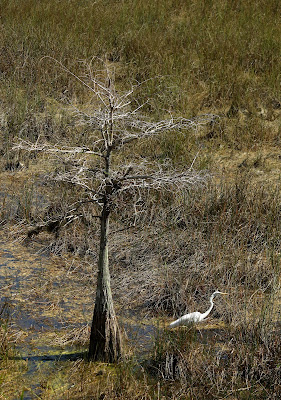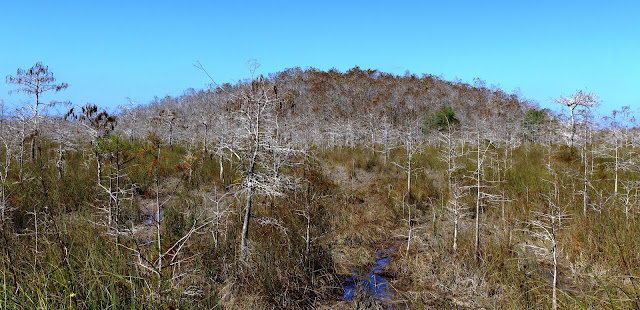We shared our campsite with this catbird. He was always around, from his mewing call just at dawn, flitting around the underbrush, or checking for some morsel we might have dropped.
The Anhinga Trail certainly did have a lot of anhingas, which are known for their beautiful feathers and holding out their wings to dry after being in the water. In the photo below you see four good sized "chicks" looking at their mother's back...and I can just imagine what she is thinking...something like, Just leave the nest already...
 |
| Anhinga "chicks" in nest with mother. |
|
|
What's the everglades without alligators? Lots of gators, and they really are just that lazy. I don't think one of them moved the whole time we were observing them. There was a certain smell about the area though.


Mahogany Hammock
George & I visited this hammock about 43 years ago, and a ranger pointed out where the owls were living up in a tree. Well I had my binoculars out and checked every possible owl spot, but couldn't find any.
In this hammock, an "island" surrounded by a sea of grass, the trees and vegetation give you, "I'm in the jungle" feel, and that has remained the same.
 |
| The boardwalk over the sawgrass to the hammock. |
 |
| The view from the hammock to the river of grass. |
 |
| An old growth mahogany tree. |
 |
| The distinctive bark of a gumbo limbo tree. |
 |
| Diane in a rare sunny spot in the otherwise deep shade of the hammock. |
 |
| A dwarf cypress and an egret amidst the sawgrass river. |
 |
| Resurrection ferns - they'll spring to life with the first rain. |
With a gain in elevation of just 1 foot above the surrounding sawgrass, cypress trees grow considerably more robust and taller forming cypress domes.
A Julia heliconian feeding on nectar and a woodstork soaring above, both at Paurotis Pond.


















No comments:
Post a Comment